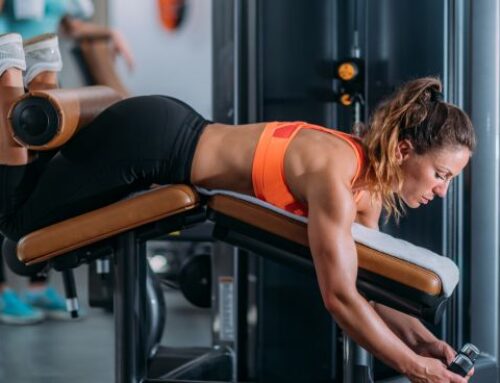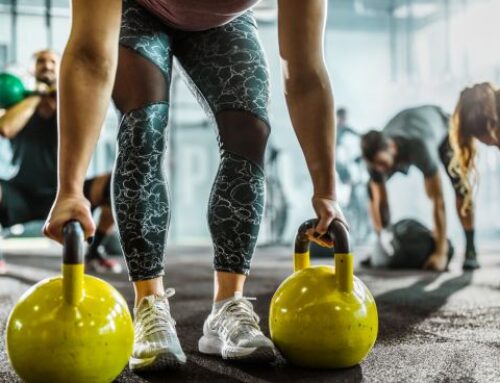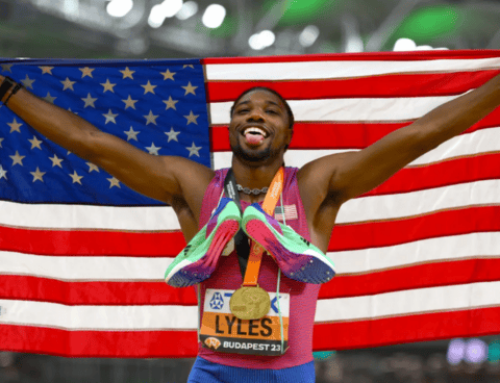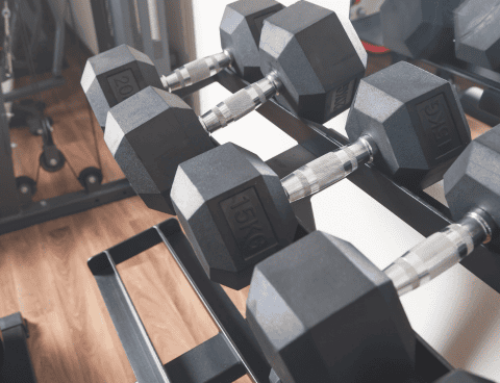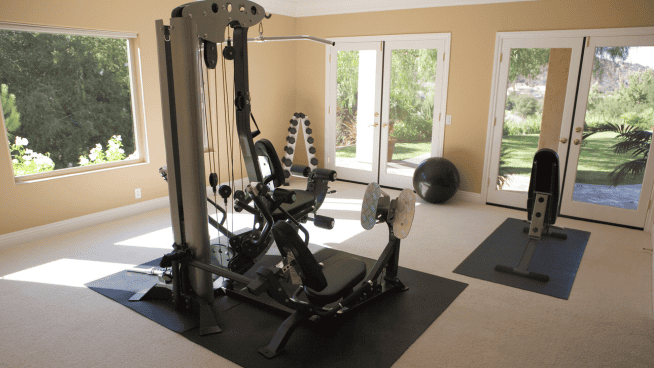How to Build a New-School Basketball Warm-Up
Like an insatiable forest fire, the metaphorical inferno of debate over dynamic and static stretching has raged on in coaching circles for far too long.
Old-school coaches have long preached static stretching and a generic battery of calisthenics for their athletes prior to practice or competition. Although they have their merits in terms of promoting recovery and improving conditioning, respectively, they nevertheless fail to match the effects of dynamic warm-ups in terms of optimizing on-court preparation.
When it comes to basketball, many coaches are still relying on outdated warm-ups. Before we get into smarter alternatives, let’s discuss the science behind it.
Why Your Warm-Up Matters
Broadly speaking, warm-ups are intended to potentiate performance and reduce injury.
Warm-ups reduce built up viscosity within muscle and myofascial structures and course synovial fluid throughout the body’s most movable joints.
Additionally, warm-ups also increase the body’s core temperature and drive blood to working localized muscles of the arms and legs. Furthermore, the separation of oxygen molecules from their red blood cell carriers (hemoglobin and myoglobin) is hastened, meaning oxygenation of working musculature is streamlined, thus increasing stamina and acute work capacity.
Though static stretching, a practice which involves achieving and maintaining a fixed joint position to facilitate a stretch of the muscles crossing it, can acutely mediate flexibility by improving the muscle’s resting length and promote recovery, it can blunt motor unit recruitment and discharge frequency, thus dampening power output.
We do not want to hinder our power output right before a competition.
Conversely, dynamic warm-up protocols, explicitly including sport-specific movements, have been found to evoke increases in nerve conduction velocity, in turn priming the body’s muscles for the work that lies aheads.
A 2012 meta-analysis found that dynamic warm-ups were effective in reducing lower extremity injuries among athletes, especially those warm-ups which contained sport specific drills.
A New-School Basketball Warm-Up
A specific warm-up is a type of dynamic warm-up characterized by eight to 12 minutes of activities or sport-specific drills that are continuously performed at gradually increasing intensities. Rarely are there dedicated rest periods. It is during the specific warm-up that dynamic movements are performed to take joints and corresponding limbs through desired excursions and ranges of motion.
Below is an actual sequence of movements I have my collegiate and professional basketball players perform prior to practice:
1. High Knee Hug Walk
- Lean torso slightly forward and grasp knee.
- Pull the knee up, “meeting” it with your chest.
- Extend through the hip of the rear leg.
2. High Knee Hug Walk to Lunge
- Lean torso slightly forward and grasp knee.
- Pull the knee up, “meeting” it with your chest.
- Extend through the hip of the rear leg.
- Release the knee and step forward.
- Drop the knee of the rear leg so it hovers over or grazes the ground.
3. High Knee Hug Walk to Lunge with Overhead Reach
- Lean torso slightly forward and grasp knee.
- Pull the knee up, “meeting” it with your chest.
- Extend through the hip of the rear leg.
- Release the knee and step forward.
- Drop the knee of the rear leg so it hovers over or grazes the ground.
- Reach overhead by upwardly rotating the shoulder blades and flexing the shoulders.
4. High Knee Hug Walk to Lunge with T-Spine Twist
- Lean torso slightly forward and grasp knee.
- Pull the knee up, “meeting” it with your chest.
- Extend through the hip of the rear leg.
- Release the knee and step forward.
- Drop the knee of the rear leg so it hovers over or grazes the ground.
- Cross or interlock your hands, getting your elbows to shoulder height.
- Rotate through the upper back and shoulders towards the knee of the front leg.
5. Inchworm to Yoga Plex
- Assume a push up position.
- Hike your hips up as you “inch” towards your palms, or until you can no longer keep your legs extended.
- Walk your hands back out to a push up position.
- Bring one leg up, so the shin is parallel with or close to the same side arm.
- Rotate through the shoulders, turning away from the front knee.
- Return to push up position and perform on the other side.
6. “Muscle March”
- While ripping the arm through, punch with the opposite knee.
- Focus on height of knee, driving through as explosively as possible.
- Keep the trunk as stable as possible to prevent rotation.
7. RDL Walk
- Take an exaggerated step forward.
- “Grab” the floor with your foot, slightly poke the knee forward and shoot the hips behind you.
- Keep the opposite and rear leg straight and shoulders in line with or slightly higher than the hips.
8. RDL Walk with Overhead Reach
- Take an exaggerated step forward.
- “Grab” the floor with your foot, slightly poke the knee forward and shoot the hips behind you.
- Keep the opposite and rear leg straight and shoulders in line with or slightly higher than the hips
- Reach overhead by upwardly rotating the shoulder blades and flexing the shoulders
9. Cradle Walk
- Lean torso slightly forward and grasp knee and foot.
- Press down on knee and bring foot upward.
- Return foot to ground and repeat step.
10. Carioca Walk with High Knee Sweep
- Perform Carioca exercise at half speed and carry knee over by driving it upwards and across the body.
- Repeat steps as desired.
11. Gliding Adduction
- With slightly bent hips, drive lead leg out and follow quickly with trail leg, rapidly squeezing them together beneath your hips.
12. High Knee Ankling
- Focus on height of knee, driving through as explosively as possible.
- Upon landing, keep ankle stiff and forcefully drive off floor at contact.
- Try to keep the trunk as stable as possible to prevent rotation.
13. Falling Acceleration Tempos (aka “Lean, Fall, Run!”)
- Upon command of coach, teammate, or training partner, let your body fall forward.
- Gather momentum as you fall and begin sprinting.
14. Deceleration to Defensive Stance
- Initially, perform these at half of “game speed.”
- As you decelerate shift your body weight back by loading your hips.
- Try to slow down as quietly as possible, before slowing down as quickly as possible.
- Gradually increase speed from which you will be slowing down.
Additionally, skill rehearsal activities and drills that integrate more complex sport-specific drills can be woven into the warm-up period.
Specific warm-ups include greater anticipatory and accelerative or “on the go” demands compared to weight room or strength training-based warm-ups. The later is skewed more toward activation and “anchoring” to enhance stability. This practice is known as movement patterning.
Movement patterning involves the assembly of drills that activate musculature specific to a given exercise, and the buildup of progressions or breakdown of regressions, respectively referred to as “ratcheting up” or “ratcheting down” a given lift, often an Olympic lift. If you’re training a basketball player in the weight room, movement patterning can be a useful way to warm up.
The emergence of a weak or sticking point will warrant the intervention of the strength coach who will guide the athlete with external cues to improved performance or make recommendations for future exercises that will enable them to kinesthetically internalize cues through enhanced stability and motor control resulting in streamlined movement.
An example of an individualized movement patterning warm-up designed for one of my professional basketball players can be found below. This was the warm-up he performed before a dynamic effort Hex Bar Block Pull:
1. Three Month Position with Belly Breathing
- Assume supine position on floor with hips, knees and shoulders flexed to 90 degrees.
- Keep head, lower back and hips against ground.
- Inhale deeply through the nose, briefly hold and exhale through the mouth.
2. Dead Bug atop Foam Roller
- Assume supine position atop foam roller.
- Keep head, lower back and hips against foam roller.
- Elevate arm off ground and flex hip and knee of opposite side.
- Reset yourself before performing subsequent repetition.
3. Single-Legged Lowering
- Assume supine position on floor.
- Keep head, lower back and hips against ground.
- Keeping leg fully straight, elevate it and try to get it in line with hips.
- Opposite leg should maintain contact with ground.
4. Slant Board Glute Bridge with Adduction
- Place feet on slant board or weight plates propped up atop stable surface.
- Insert light medicine ball between knees.
- Lie back in supine position.
- Squeeze medicine ball between knees and drive through heels to elevate hips.
5. RNT Hinge
- Affix a band behind knees.
- Walk back until you feel tension in band.
- Place feet at shoulder width.
- Allow the knees to slightly poke forward.
- Keeping spine long, shoot hips as far back as you can.
- Return to starting position by driving heels through ground to extend hips.
6. Band Stomp with Knee Extension
- With band looped overhead or secured to barbell or stationary equipment, place foot inside.
- Band should run below mid-foot.
- Standing upright, supported or unsupported, drive foot downward to extend hip and knee.
- Hold for thousand count.
7. Bowler Squat
- Procure light medicine ball or weight plate.
- “Grab” the floor with your foot, jut the knee forward and shoot the hips back and down with the knee of the opposite leg bent.
- Briefly hold this position and a sweep medicine ball or weight plate diagonally across your body and in front of front leg.
- Return the medicine ball or weight plate to starting position before completing another repetition.
- Maintain knee and hip positioning throughout set.
The exact warm-up above optimized activation patterns of smaller, intrinsic core muscles that stabilize the lumbar spine and lock down the ribcage, acutely increase the extensibility of the hamstrings while activating the hip flexors (both needed for positional stability prior to the pull), awakened the glutes, which are heavily involved in hip extension, and promoted leg drive, one of the most overlooked aspects of deadlift variations.
In tandem, core stability, posterior chain extensibility and glute activation lends themselves to explosiveness on the court, particularly movements which involve triple extension such as jumping, sprinting, or moving laterally.
References:
Behm, D.G., Peach, A., Maddigan, M., Aboodarda, S.J., DiSanto, M.C., Button, D.C., & Maffiuletti, N.A. (2013). “Massage and stretching reduce spinal reflex excitability without affective twitch contractile properties.” Journal of Electromyography and Kinesiology, 23, 1215-1221.
Herman, K., Barton, C., Malliaras, P., & Morrissey, D. (2012). “The effectiveness of neuromuscular warm-up strategies, that require no additional equipment, for preventing lower limb injuries during sports participation: a systematic review.” BMC Medicine, 10 (75), 1-12.
Photo Credit: FatCamera/iStock
READ MORE:
RECOMMENDED FOR YOU
MOST POPULAR
How to Build a New-School Basketball Warm-Up
Like an insatiable forest fire, the metaphorical inferno of debate over dynamic and static stretching has raged on in coaching circles for far too long.
Old-school coaches have long preached static stretching and a generic battery of calisthenics for their athletes prior to practice or competition. Although they have their merits in terms of promoting recovery and improving conditioning, respectively, they nevertheless fail to match the effects of dynamic warm-ups in terms of optimizing on-court preparation.
When it comes to basketball, many coaches are still relying on outdated warm-ups. Before we get into smarter alternatives, let’s discuss the science behind it.
Why Your Warm-Up Matters
Broadly speaking, warm-ups are intended to potentiate performance and reduce injury.
Warm-ups reduce built up viscosity within muscle and myofascial structures and course synovial fluid throughout the body’s most movable joints.
Additionally, warm-ups also increase the body’s core temperature and drive blood to working localized muscles of the arms and legs. Furthermore, the separation of oxygen molecules from their red blood cell carriers (hemoglobin and myoglobin) is hastened, meaning oxygenation of working musculature is streamlined, thus increasing stamina and acute work capacity.
Though static stretching, a practice which involves achieving and maintaining a fixed joint position to facilitate a stretch of the muscles crossing it, can acutely mediate flexibility by improving the muscle’s resting length and promote recovery, it can blunt motor unit recruitment and discharge frequency, thus dampening power output.
We do not want to hinder our power output right before a competition.
Conversely, dynamic warm-up protocols, explicitly including sport-specific movements, have been found to evoke increases in nerve conduction velocity, in turn priming the body’s muscles for the work that lies aheads.
A 2012 meta-analysis found that dynamic warm-ups were effective in reducing lower extremity injuries among athletes, especially those warm-ups which contained sport specific drills.
A New-School Basketball Warm-Up
A specific warm-up is a type of dynamic warm-up characterized by eight to 12 minutes of activities or sport-specific drills that are continuously performed at gradually increasing intensities. Rarely are there dedicated rest periods. It is during the specific warm-up that dynamic movements are performed to take joints and corresponding limbs through desired excursions and ranges of motion.
Below is an actual sequence of movements I have my collegiate and professional basketball players perform prior to practice:
1. High Knee Hug Walk
- Lean torso slightly forward and grasp knee.
- Pull the knee up, “meeting” it with your chest.
- Extend through the hip of the rear leg.
2. High Knee Hug Walk to Lunge
- Lean torso slightly forward and grasp knee.
- Pull the knee up, “meeting” it with your chest.
- Extend through the hip of the rear leg.
- Release the knee and step forward.
- Drop the knee of the rear leg so it hovers over or grazes the ground.
3. High Knee Hug Walk to Lunge with Overhead Reach
- Lean torso slightly forward and grasp knee.
- Pull the knee up, “meeting” it with your chest.
- Extend through the hip of the rear leg.
- Release the knee and step forward.
- Drop the knee of the rear leg so it hovers over or grazes the ground.
- Reach overhead by upwardly rotating the shoulder blades and flexing the shoulders.
4. High Knee Hug Walk to Lunge with T-Spine Twist
- Lean torso slightly forward and grasp knee.
- Pull the knee up, “meeting” it with your chest.
- Extend through the hip of the rear leg.
- Release the knee and step forward.
- Drop the knee of the rear leg so it hovers over or grazes the ground.
- Cross or interlock your hands, getting your elbows to shoulder height.
- Rotate through the upper back and shoulders towards the knee of the front leg.
5. Inchworm to Yoga Plex
- Assume a push up position.
- Hike your hips up as you “inch” towards your palms, or until you can no longer keep your legs extended.
- Walk your hands back out to a push up position.
- Bring one leg up, so the shin is parallel with or close to the same side arm.
- Rotate through the shoulders, turning away from the front knee.
- Return to push up position and perform on the other side.
6. “Muscle March”
- While ripping the arm through, punch with the opposite knee.
- Focus on height of knee, driving through as explosively as possible.
- Keep the trunk as stable as possible to prevent rotation.
7. RDL Walk
- Take an exaggerated step forward.
- “Grab” the floor with your foot, slightly poke the knee forward and shoot the hips behind you.
- Keep the opposite and rear leg straight and shoulders in line with or slightly higher than the hips.
8. RDL Walk with Overhead Reach
- Take an exaggerated step forward.
- “Grab” the floor with your foot, slightly poke the knee forward and shoot the hips behind you.
- Keep the opposite and rear leg straight and shoulders in line with or slightly higher than the hips
- Reach overhead by upwardly rotating the shoulder blades and flexing the shoulders
9. Cradle Walk
- Lean torso slightly forward and grasp knee and foot.
- Press down on knee and bring foot upward.
- Return foot to ground and repeat step.
10. Carioca Walk with High Knee Sweep
- Perform Carioca exercise at half speed and carry knee over by driving it upwards and across the body.
- Repeat steps as desired.
11. Gliding Adduction
- With slightly bent hips, drive lead leg out and follow quickly with trail leg, rapidly squeezing them together beneath your hips.
12. High Knee Ankling
- Focus on height of knee, driving through as explosively as possible.
- Upon landing, keep ankle stiff and forcefully drive off floor at contact.
- Try to keep the trunk as stable as possible to prevent rotation.
13. Falling Acceleration Tempos (aka “Lean, Fall, Run!”)
- Upon command of coach, teammate, or training partner, let your body fall forward.
- Gather momentum as you fall and begin sprinting.
14. Deceleration to Defensive Stance
- Initially, perform these at half of “game speed.”
- As you decelerate shift your body weight back by loading your hips.
- Try to slow down as quietly as possible, before slowing down as quickly as possible.
- Gradually increase speed from which you will be slowing down.
Additionally, skill rehearsal activities and drills that integrate more complex sport-specific drills can be woven into the warm-up period.
Specific warm-ups include greater anticipatory and accelerative or “on the go” demands compared to weight room or strength training-based warm-ups. The later is skewed more toward activation and “anchoring” to enhance stability. This practice is known as movement patterning.
Movement patterning involves the assembly of drills that activate musculature specific to a given exercise, and the buildup of progressions or breakdown of regressions, respectively referred to as “ratcheting up” or “ratcheting down” a given lift, often an Olympic lift. If you’re training a basketball player in the weight room, movement patterning can be a useful way to warm up.
The emergence of a weak or sticking point will warrant the intervention of the strength coach who will guide the athlete with external cues to improved performance or make recommendations for future exercises that will enable them to kinesthetically internalize cues through enhanced stability and motor control resulting in streamlined movement.
An example of an individualized movement patterning warm-up designed for one of my professional basketball players can be found below. This was the warm-up he performed before a dynamic effort Hex Bar Block Pull:
1. Three Month Position with Belly Breathing
- Assume supine position on floor with hips, knees and shoulders flexed to 90 degrees.
- Keep head, lower back and hips against ground.
- Inhale deeply through the nose, briefly hold and exhale through the mouth.
2. Dead Bug atop Foam Roller
- Assume supine position atop foam roller.
- Keep head, lower back and hips against foam roller.
- Elevate arm off ground and flex hip and knee of opposite side.
- Reset yourself before performing subsequent repetition.
3. Single-Legged Lowering
- Assume supine position on floor.
- Keep head, lower back and hips against ground.
- Keeping leg fully straight, elevate it and try to get it in line with hips.
- Opposite leg should maintain contact with ground.
4. Slant Board Glute Bridge with Adduction
- Place feet on slant board or weight plates propped up atop stable surface.
- Insert light medicine ball between knees.
- Lie back in supine position.
- Squeeze medicine ball between knees and drive through heels to elevate hips.
5. RNT Hinge
- Affix a band behind knees.
- Walk back until you feel tension in band.
- Place feet at shoulder width.
- Allow the knees to slightly poke forward.
- Keeping spine long, shoot hips as far back as you can.
- Return to starting position by driving heels through ground to extend hips.
6. Band Stomp with Knee Extension
- With band looped overhead or secured to barbell or stationary equipment, place foot inside.
- Band should run below mid-foot.
- Standing upright, supported or unsupported, drive foot downward to extend hip and knee.
- Hold for thousand count.
7. Bowler Squat
- Procure light medicine ball or weight plate.
- “Grab” the floor with your foot, jut the knee forward and shoot the hips back and down with the knee of the opposite leg bent.
- Briefly hold this position and a sweep medicine ball or weight plate diagonally across your body and in front of front leg.
- Return the medicine ball or weight plate to starting position before completing another repetition.
- Maintain knee and hip positioning throughout set.
The exact warm-up above optimized activation patterns of smaller, intrinsic core muscles that stabilize the lumbar spine and lock down the ribcage, acutely increase the extensibility of the hamstrings while activating the hip flexors (both needed for positional stability prior to the pull), awakened the glutes, which are heavily involved in hip extension, and promoted leg drive, one of the most overlooked aspects of deadlift variations.
In tandem, core stability, posterior chain extensibility and glute activation lends themselves to explosiveness on the court, particularly movements which involve triple extension such as jumping, sprinting, or moving laterally.
References:
Behm, D.G., Peach, A., Maddigan, M., Aboodarda, S.J., DiSanto, M.C., Button, D.C., & Maffiuletti, N.A. (2013). “Massage and stretching reduce spinal reflex excitability without affective twitch contractile properties.” Journal of Electromyography and Kinesiology, 23, 1215-1221.
Herman, K., Barton, C., Malliaras, P., & Morrissey, D. (2012). “The effectiveness of neuromuscular warm-up strategies, that require no additional equipment, for preventing lower limb injuries during sports participation: a systematic review.” BMC Medicine, 10 (75), 1-12.
Photo Credit: FatCamera/iStock
READ MORE:

